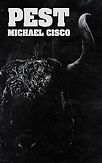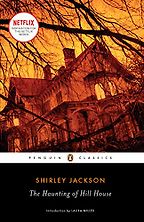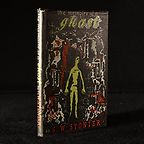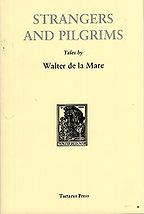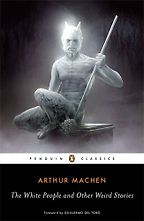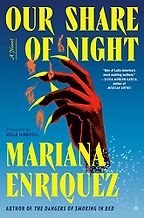Before we talk about your choices today, could you start by telling us what ‘weird fiction’ is?
We can regard it as an offshoot of horror fiction that dwells particularly on the supernatural, and on the way that the existence of the supernatural throws all experience into doubt.
When I was a kid, around Halloween the local TV stations would run clip shows; they’d have somebody standing in what looked like a lab or a dungeon or something, introducing clips of whatever horror movies they had lying around. And they’d always pontificate in a scholarly way about horror, and say, “Why are we drawn to horror? Why do we love to be scared?” And I thought, “I don’t love to be scared! I hate being scared!” That never sat well with me – it didn’t seem quite right.
So I was trying to reckon with what the appeal of weird fiction is, and it’s tied up with what makes it frightening, but also what makes it attractive… I think it’s this: people have a feeling that everything’s been explained a little bit too much, and that life has been made too predictable. Normal life starts to acquire a suffocating, oppressive, fantasy-killing, desire-destroying aspect. The normal is very safe, but maybe it’s too safe. Weird fiction talks very directly to that feeling, which is why so many weird tales are set in ordinary circumstances, in regular places, where even a minor alteration can be shocking. Then you can go one of two ways… You can be more conservative and say, “Here’s the shocking event that could happen – aren’t you glad to have a normal, boring life?” But then there’s the other part of us that may say, “I don’t want everything predicted in advance and laid out for me.”
And this isn’t just about a feeling. It’s also true that no matter how good we get at predicting things, no amount of prediction could have told me ten years ago what my life was going to be like now. Experience doesn’t have to listen to us when we predict what it’s going to do: it does what it does. That’s something that I pompously call ‘the infinity of experience’. I think weird fiction tries to draw our attention to that in a very particular way: not by confronting us with things like war and torture and actual atrocities, but with something subtler, more uncertain and disquieting.
So Henry: Portrait of a Serial Killer is a horror movie, but not a weird tale; whereas Picnic at Hanging Rock, that’s a weird tale. It doesn’t have to do with how gory it is, but it has to do with the impression you’re trying to make.
Let’s start in 1959 with your first choice: The Haunting of Hill House by Shirley Jackson. Could you introduce us?
Like a lot of people, I learned about this book because Stephen King raved about it, and said it was the greatest haunted house book ever written. I read it straight through, in one sitting. I just couldn’t stop. It’s not that long, and it’s gripping.
It’s a psychic investigation story, based on investigators in England like George Playfair. They conducted an investigation of what they called ‘the most haunted house in England’, Borley Rectory, where writing would appear on the walls and things would move and so forth. Shirley Jackson loved ghost stories, but it was reading about an investigation of ghosts that set her mind in motion to write Hill House. It’s interesting, because these are characters who are seeking out ghosts. They’re not moving into a new home that’s suspiciously inexpensive, and discovering mysterious things and gradually figuring out that it’s haunted. We know the house is haunted; that question has been neatly removed from the story. The question is, why would you want to go there? All the characters have somewhat different reasons, of varying degrees of seriousness.
What Jackson gets across so beautifully is Hill House itself. She says it’s stood for 80 years; this would have been in 1959 when the book was published, so maybe 1879, a Victorian house in New England. It’s on an estate surrounded by grounds, and there’s a gate; it’s a house that says, “No, stay back. I’m more important than you are.” When Eleanor drives up to the house, it looms over her, and she is struck immediately by the sense that it’s vile and hideous – but at the same time, the word used is ‘arrogant’. The house is gazing haughtily down at her, and it’s not a crumbling ruin. It’s perfect. In the film, they do this beautifully; Eleanor comes in and puts her bags down, and when she reaches down for them again, she can see her reflection in the floor. It’s that polished. Everything is buffed, cleaned, dust-free, cobweb-free, comfortable, overly-ornamented, oppressive, heavy and confusing. You don’t know where you are in the house relative to any other part because of the way it’s laid out. So it’s a kind of labyrinth, and it’s all about social distance and snobbery.
Eleanor is someone who has no place in the world, and like a lot of Jackson’s characters, she’s seeking admittance somewhere. She wants to belong and be cared about and be part of something, but nobody wants her. And this is very unfair, because there’s nothing wrong with her! She’s something like 33, which means she’s terribly over the hill and doomed, because she spent her life selflessly taking care of her nasty invalid mother while her sister went off to have a husband. And now her mother’s dead… Hill House is a horrifying place, but at the same time, it wants her. She tries to side with the house eventually.
An unusually rich setup for a haunted house!
This is how it opens, and the minute you read this, you know what you’re getting into:
“No live organism can continue for long to exist sanely under conditions of absolute reality; even larks and katydids are supposed, by some, to dream. Hill House, not sane, stood by itself against the hills, holding darkness within; it had stood so for eighty years and might stand for eighty more. Within, walls continued upright, bricks met neatly, floors were firm, and doors were sensibly shut; silence lay steadily against the wood and stone of Hill House, and whatever walked there, walked alone.”
… and that’s reprised at the end of the book. So if that’s the case, then her hope for belonging and company is an illusion, and she’s just going to end up walking alone there forever, too.
The house embodies a sense of ambivalence about connecting, a snobbery and self-importance. Part of the reason Eleanor was selected for this experiment is that she had a psychic experience as a child, where showers of stones would fall on her house, and there were newspaper articles about it. At one point, she blurts out, “The neighbours threw the stones in. My mother said that they didn’t like us because we wouldn’t mix with them” – so her mother’s not only a tyrant, but is also withholding the rest of the family from everyone else, because of self-importance. So you can see why Hill House would have a certain vestigial appeal to Eleanor.
The book is so rich and so tightly written. You can’t put it down, but also, if you look at it slowly and carefully, it really rewards sustained attention. It deserves all the praise that it gets. In fact, it probably deserves more.
Not all haunted houses are weird – but this one is?
Yes. As a piece of weird fiction, it’s really unique. It’s hard to write a weird novel. This one has a sustained intensity of effect that is achieved without having to resort to terribly drastic things happening. There’s a moment where the two characters are walking out in the grounds around Hill House, and it’s daytime, and they stumble across a ghostly picnic. The sun is shining, there’s a gambolling puppy on the lawn – it’s a family having a perfectly benign picnic, and it’s the most terrifying thing in the book. Nothing gruesome happens, but it’s been positioned just so and with such care, and the characters are in exactly the right place emotionally, so that they’re horrified. And that’s like a magic trick. I can’t explain how you do that, but it’s such a quintessentially weird thing, to shock and horrify you with something benign and ordinary.
The whole book is written with that degree of care and deliberation. Shirley Jackson is uncannily aware of where the reader is and what they are seeing, what they know, what they don’t know…
Tell us about your second choice, Memoirs of a Ghost by G. W. Stonier.
Unfortunately, it’s quite an obscurity. This was published in 1947, and there may be some debate about whether or not it’s weird fiction – but the main character is a ghost, what more do you want? Stonier wrote a comic novel originally called Shaving Through The Blitz. This is his follow-up. The main character in this book is killed by a bomb during the Blitz right away, and this is his experience as a ghost. He is wandering; he doesn’t move on, he just becomes a mute, perennial witness. He’s still subject to terror. Being dead is depicted as nightmarish, but its intensity is very quiet. It’s not about being chased by monsters or anything like that. It’s more about a feeling of outsideness, which Stonier captures so well. The ghost is more or less like a homeless person.
I remember stumbling across this book purely based on the strength of the title, and then reading it and being completely stunned by the beauty of the writing. It’s a gorgeously written book, the prose is immaculate. You can just open it anywhere… Here, this is the beginning of a chapter I just chose at random: “From my corridor I watched the flakes falling, hurrying, delaying, inveigling, with a soft touch of nightmare. My hands were quite blue. I had been driven by the cold to the shelter of this corridor, which ran alongside a ruined shop; the farther end, where one might have expected a staircase, had been blocked by rubble. And there, with knees drawn up, I sat staring at the cinematograph of the snow.” You dip into this book anywhere, and there’s this very careful, vivid, descriptive prose. You couldn’t sustain this density for a very long book – it’s too concentrated, it would be exhausting to read. It occupies just the right amount of space.
You mentioned that its ‘weird’ status is debatable…?
It could be said that this is too metaphorical or poetic to be weird fiction. It doesn’t matter, because it’s a good book and worth reading, whether it’s technically weird or not. But the aesthetic effect of it is like weird fiction, in that it helps to make us see things around us as mysterious. From the point of view of a ghost, everything ordinary becomes alluring and exotic, because you’re now incomprehensibly divorced from everything. It’s not yours anymore. That adds mystery and poignance, and gives the story its power.
This is a very particular response to a devastating war, to actual atrocity. It does what a lot of the best poetry does: it takes painful, difficult things, and without in any way failing to give what is owed to that pain, it nevertheless makes it beautiful. You acquire a kind of power over it by telling its story and by finding beauty in it. You’re not excusing it. You’re doing what you have to do to continue, and to keep it from killing you.
That helps us understand what ghosts are. They’re not just an arbitrarily conjured menace – they’re more meaningful than that. They have to do with memory and so on, but they also have to do with a certain kind of experience… You can have an experience where you feel like a ghost, in the sense that you’re somehow not part of what’s around you. A good ghost story can reach that feeling and express it very efficiently.
This isn’t a book with a plot. There’s certainly no mystery: we know he’s dead, he knows he’s dead. It’s more like a sustained meditation on life and death. I think for all that it has a kind of horror to it, and he doesn’t sugarcoat what this experience is like, it’s a healing book. If you’ve gone through any experience that’s at all like this, or if you suffer from depression, this is a book that is not going to make you better, but you can have a conversation with. And you can understand, too, that this is part and parcel of the human experience.
That’s heavy-handed praise, but the main reason to read it is that it’s beautiful. Come for the beautiful prose, and stay for whatever ideas it gives you.
It’s formally experimental too, getting increasingly fragmented – is that typical for weird fiction?
It can be… A lot of weird fiction is very quaint and cozy, and those are typically the more reassuring stories, where the ghost reappears and points out their murderer and justice is done and there’s comeuppance. Those stories tell us that the universe is fundamentally moral. But you will see some weird fiction that gets formally innovative, in some cases more obviously than others – like Robert Aickman, for example. His work isn’t weird-looking on the page or anything, and his tone is usually rather bland, but there’s an interesting dichotomy between the bland tone and the utterly bizarre things that he’s describing; it’s almost aggressively normal, in a way that throws you off. So there can be that kind of subtle innovation…
Weird fiction often plays with perspective in ways that other stories don’t. You can go all the way back to Poe. “The Imp of the Perverse”, when you start reading it, is a lecture or an essay about an interesting psychological phenomenon, and then, about halfway through, the speaker starts casually referring to how he murdered his cousin. Poe’s pulled a trick there. And there’s an irony, which Jackson uses all the time in a much more subtle way, where you have to ask, “Who am I, watching this?” And sometimes there’s use of epistolary formats or things like that, ways of blocking off parts of the narrative so you don’t see too much too quickly… Those are aspects of form that are often important in weird fiction.
Then you get into what is called ‘new weird’, which involves more modern writers like China Miéville. There’s a percolation of literary techniques from modernism and post-modernism, new techniques and approaches being brought into weird fiction to enrich the genre. M. John Harrison did that earlier, Paul G. Tremblay does that now…
Your own novel Pest switches perspectives and narrative threads and levels of reality, but somehow creates an overall coherence… Could you tell us about the book, and a little about the process? I’m guessing there wasn’t a three-act plan here…
Pest centres around a character named Chalo, who leads a double life, or maybe multiple lives over different incarnations. On the one hand, he’s a very large civil engineer from Southern California, born in Bangladesh; but either before or after that life or concurrent with it, he’s also a wild Tibetan Yak. So we switch back and forth between his human life and his yak life. In his yak life, the main plot line involves the impending rut and how he’s going to deal with that. In his human life, he’s been asked by a very Californian guru-wizard-sage type to design and help construct a campus on Catalina Island, which is just off the coast of Southern California, where he prophesies that something is going to come and visit Earth. He’s asking Chalo to design and build the place where that will happen. So you know – a typical book.
As for how the book came about… I keep my antenna out for ideas that I find striking, I collect them over a period of time, and then I start to get an inkling of how they can fit together – and more importantly, the ones that want to fit together. No, I don’t have a three-act structure with bullet points. You write how you have to write, all that matters is whether the end result is good; I just personally feel like, if I’m going to write a detailed outline of what’s going to happen, then just publish that. For me, I want to surrender a lot of the control to the book and the characters, and I need to know that what’s happening is happening because of the characters, rather than what I need to happen. There’ll be a certain amount of what I need in there, which is fine – if it’s a struggle, that’s better, because then I feel there’s something that’s resisting or disagreeing, and it’s alive. It’s not for me to control it. It’s for me to hear what it’s saying and occasionally reason with it and say, “That’s not going to work”, or “Don’t go there.” And maybe it’ll grudgingly agree, or maybe just fold its arms and refuse to budge until I do as it tells me. That, for me, is a lot of the joy of the writing of the book – the way that the imaginary elements take on a life of their own and run amok.
I know how my books will end. I have that in view, and I know there’s certain key moments that have to happen. Not because the plot says, “We have to have a climax” – it’s more like, I vividly saw this. The struggle is more keeping it from becoming too chaotic and messy, too annoying to read, too unrewarding, or confusing.
The book isn’t formless. I feel like it has a pretty clear propulsion through. I want to have something like a plot, I’m not snobbish about that. But there were just various things I wanted to do. I wanted demons to go to a bank and negotiate, and get into a magical-economic-banking versus demonic-world duel, because I just thought that was funny, and true in a weird way. So that had to go in the book. I needed a way to bring all these elements together into something that wouldn’t just seem like a pile of stuff, where they would resonate meaningfully next to each other. That all sounds very abstract, but it’s not when you do it. You’re just tacking toward whatever is good, and you’re saying, “Can I steer these together and have them in the same place, at the same time?” And when it works, then it starts to produce yet more ideas…
There are so many ideas in this one. Did the yak idea come first?
I can’t really point to a moment where I said, “I think Chalo is a yak sometimes.” It was just… I like yaks. They have a funny name, but they’re huge, dramatic animals. And then thinking about the rut and what it’s like to have a mating season, where you’re only sexual for a chunk of time each year – what’s that like? How do you know it’s starting? And if you’re a male, then you would perceive this as a desire to start randomly picking fights and clobbering other males… It’s innately funny to me, but there’s a pathos to it too, because they’re beasts, and they can’t help it. You can imagine a philosophically resigned yak: “Here we go again.” And that affords you opportunities for reflecting on all sorts of things that we as humans are compelled to do, where we say, “Here we go again…”
Let’s talk about your third choice, a collection of short stories: Strangers and Pilgrims, by Walter de la Mare.
De La Mare made his name as a poet, but he wrote quite a lot of weird fiction, and it doesn’t get quite as much attention as it might. I think he’s every bit as great as Aickman or Machin. He was a poet, so he had an extraordinary gift for language, and he certainly took his time writing stories. There was no dashing through one of his stories; the aesthetic confidence and control that he has is perfect. He knows exactly what he’s doing, all the time.
He’s a good example of stories that are very normal for the most part, in undramatic settings – and at the end, it’s kind of hard to say what just happened. It’s not quite like Aickman, who really leans into making everything highly ambiguous and raising as many questions as possible. De La Mare isn’t as compulsive about that…
Because he’s a poet, his stuff is fantastic when you read it out loud. He had that poetic ear for language and for sound, and for particularly ominous and suggestive dialogue. There’s a BBC short series with an adaptation of “Seton’s Aunt”, narrated by Toby Jones. The story is framed around this sinister relative who may be a witch; hearing Toby Jones doing this vocal drag as Seton’s Aunt is a true delight.
The magic of De La Mare’s stories is that they always go on a little longer than they should, and you’re always a little confused as to why it’s still going – but there’s something about that, and the way his characters are too comfortable with the weird things that have happened, and perhaps not fully acknowledging them. It seems like it’s a dodge – but that’s what people do. They run away from the weird, scary things that happen to them. Those endings are justified because they capture that smoothing over and forgetting and blurring. Propriety is maintained. There’s something very arch about that observation. So, as a weird fiction writer, his stuff is among the subtlest, but it gives you more opportunity to mull it over. His stories hang in the air after you’re done, and you keep thinking about them and wondering, “What was that exactly?”
A sort of pleasing bafflement?
It’s very easy to baffle people by throwing in a bunch of random stuff. It’s very hard to baffle people in a way that they won’t find unsatisfying. If you can baffle people and they come away feeling like they enjoyed what you just did, then you really won.
I’ll mention David Lynch here. You may not understand what’s happening in his films, but that adds to your appreciation rather than detracting from it. That’s very hard to do. Most people, when they don’t understand something, tune it out. Keeping people intrigued requires a certain gift.
I know I selected this collection of short stories, but I could also put in a plug for his novels. He wrote one called The Return, which is really strange. This guy falls asleep next to a 16th-century alchemist’s tomb, and when he wakes up, he’s the alchemist, or at least he thinks he is, but he still looks like himself, and he still talks like himself. Is he possessed? Is he crazy? Well, people don’t go crazy like that – in a way, he’s just decided, “You know what, I’m not who I said. I’m somebody else now.” So what happens if you just arbitrarily do that? The other one is called Memoirs of a Midget, and it’s the life story of a woman who’s impossibly small. It’s not an exceptionally peculiar idea on its face, but it’s quite a thick book, and I like the wilful displacement of perspective to an odd angle for chapter after chapter. You won’t read anything else like it.
I sort-of have, though… As you were describing it, I was thinking of the Mrs Pepperpot books for children. Come to think of it, the premises of a lot of children’s books feel like weird fiction, if you changed the tone…
Yes. Like Joan Aiken: she wrote some good weird fiction as well as her children’s books. We know her for The Wolves of Willoughby Chase, but I hadn’t realized for years that that’s part of a whole series with an alternate history of Britain in it. I’ll put in a quick plug for a story she did called “The Lodgers”, which is a great little piece of weird fiction. She’s unsung as a weird fiction writer.
And your next recommendation is a short story again… Tell us about “The White People” by Arthur Machen.
This is maybe not the most original choice, but when you’re talking about weird fiction, it’s indispensable. Machen was a really interesting writer. He was born in Wales in the late 19th century, and was a member of the Golden Dawn, so he had occult interest – but he wasn’t kooky. He wrote quite a lot about London. He was a great walker, very peripatetic, and he would do these psychogeographies of places, both landscapes and cityscapes. He wrote a book called The Hill of Dreams, which was very well received; that was mystical, very much like William Blake.
The White People is probably my favourite weird tale. It has a philosophical preface, with two very English people talking about the nature of sin and this and that. But the bulk of it purports to be the diary of a seventeen-year-old girl. This girl has been raised in the countryside, and her parents are absent. Her father’s alive, but he doesn’t have any time for her. She’s very alone. She doesn’t mention any friends. She pretty much just has her governess, and she spends a lot of her time rambling in the countryside.
As she’s narrating events, she keeps making references to strange things. She says there are red days and white days. She mentions a game that her governess taught her called Troy Town, where you walk in a certain way, and then you can make people do what you want. And there was that time she turned the kitchen upside down, and boy, wasn’t the cook scared? She’s talking about all the things she can remember… and there were times when she was a child in her crib and little white faces would come and look at her, and talk to her in their language. So she’s been raised partially on the fringes of fairy land, really, but she’s so naive, she doesn’t understand that’s not supposed to be possible.
It’s clear that her governess is some kind of witch – not a sinister witch who’s trying to do anything, just someone who inherited very old practices, and because she’s in charge of her, she teaches her these things. And there’s this really chilling moment: the governess is carrying the little girl when she’s still very small, maybe three, and she puts her down under a tree for a while. There’s a man who’s been following them, and he and the governess go into the woods together. And from the other side of the wood, the white people come out, and they dance, and they look noble and terribly sad, and then they go away and the governess comes back out again. So what just happened? The girl doesn’t know. She just knows that she saw these white people, and when the governess realises she saw them, she’s very shaken… It’s very beautiful, and it’s very alarming. What are those people? They don’t menace the child, they don’t pay any attention to her – they’re involved in their own thing.
The girl keeps recalling fairy tales, but they take on this ominous significance. And if you pay attention, you notice they tend to be about marriage, and about this other side that’s made a prior claim on the bride – and you remember, she’s seventeen, so as a good middle-class English girl from a banking family, marriage is around the corner for her. Gee, I wonder why she’s thinking about that…? But she’s not mature enough to understand that that’s where she’s going.
It has that chilling feel of classic fairy…
You start to get an almost atavistic idea of what it was like to look out at the hills or the landscape and think that fairies are out there – that there’s something watching, something there that looks back. You’ve got to be careful: some people don’t come back. Some people come back changed. It’s that kind of English, psychedelic pastoral writing, where you go out into the countryside and everything gets dreamy and weird and disorienting.
The device of telling the story from the girl’s point of view, so there’s no outside reference to the isolation of her perspective, is a brilliant touch. It makes for a story that won’t leave you alone after you’ve read it. You won’t look at a lush green landscape quite the same way ever again. It brings the landscape to life – in some ways, it makes it more like it used to be when you were a child. So many of my fondest memories of watching movies or reading books as a child involve my being scared out of my wits by them. It’s odd to be nostalgic for that feeling, but I think it has to do with the sense that the world seemed a lot bigger and less predictable. I never want that feeling to die. I want to look out and feel that eeriness, because it means that the world is alive, that possibilities exist.
We’ve come to your last choice. Could you introduce Maria Enriquez’s Our Share of Night?
Enriquez is a contemporary writer from Argentina, and she’s written some short fiction that I was already familiar with. This novel only just came out, and it’s brilliant. It’s a good-sized novel, and manages to sustain weirdness for the entire duration of the book without straining. It’s a recognisably Latin American book, not just in the sense of place, but in the way that it discusses things like politics and art… There’s no sense that you’re just supposed to tell stories, and not talk about this or that. Instead, there’s a sense that, as a writer, it’s what you do – you talk about politics and gender relations and things like this. You don’t lecture or scold or preach, but they’re part of the fabric of life. So all of that is in there. It’s absolutely serious, and the weird stuff isn’t a diversion – it grows very organically.
The story is mainly about a man who is part of a cult. There are certain sensitive individuals who are selected by this cult, and used to conduct a ritual that makes contact with something. The cultists themselves, even the ones at the top, really don’t know what they’re doing. They know they make contact with this thing, and it helps keep them rich and powerful. And yes, it does involve children being sacrificed, and they do have them in cages down in a tunnel by the river, and we don’t talk about that… The main character does not want his son to get trapped by these assholes. He wants to keep him away, and that’s the main thrust of the plot.
The way the magic is worked into the story is so deft. It’s not so subtle or elusive that it feels half-assed, or like she just waved her hand at the mystery, and didn’t really have a clear idea. No, it’s very clear. There’s this kind of darkness that appears, and you have to touch the dark; it is as vivid and as clearly realized as a Stephen King monster. And like The Haunting of Hill House, it reflects a sense of snobbery and arrogance. There’s a certain kind of power where just because of who I am, you defer to me – because of certain abstract symbols (which we might call money), and because of certain mystical calculations (which could be spells or investment schemes or whatever), I shape your life. I determine what is or isn’t possible. It’s really about not making a fuss over differing between that, and what’s actually magical.
It’s such an intelligent book, you just feel like you’re getting smarter as you read it. And it respects you so much, too. It’s not just telling a story to while away a few hours, it’s trying to enrich your understanding of the world. It’s inspired and fresh and relevant, and it revitalizes your sense of what the genre can do – that it has its own way of telling the truth, and capturing real human experiences in a way that other genres can’t.
Enriquez is very clearly steeped in writers like Stephen King and so forth, but at the same time, it’s so much her own voice. She’s absolutely in command of the material throughout. It’s a long book, but it never flags: you never feel like there’s anything self-indulgent, and she’s never scolding you or preaching at you or anything like that. And she’s writing now, so there’s the great joy of knowing that hopefully there’ll be more. She just did a great collection of short stories called A Sunny Place for Shady People. It’s a little harder to talk about because it’s so new, and I don’t have the advantage of so much hindsight with it, but I see it taking weird fiction in a very mature direction. You could go from reading Miéville into Enriquez and you would see certain lines fleshed out, developed and made fuller. It’s really extraordinary.
Five Books aims to keep its book recommendations and interviews up to date. If you are the interviewee and would like to update your choice of books (or even just what you say about them) please email us at [email protected]
Five Books interviews are expensive to produce. If you've enjoyed this interview, please support us by donating a small amount.

